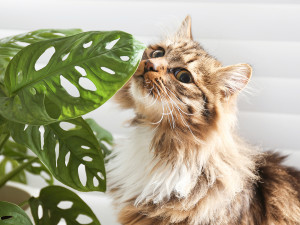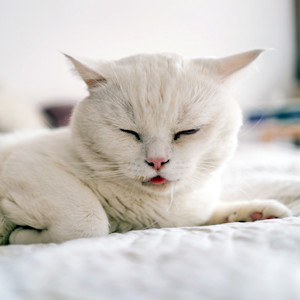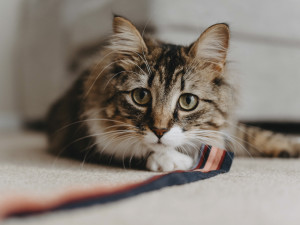Why Is Your Cat Vomiting Like They Partied All Night?
Here’s when you should worry if your cat is throwing up

Share Article
OK, your cat threw up again. Your first thought is probably, ‘Ew, gross’. But your second thought might be, ‘Oh no, what’s happening?’ While you can typically pinpoint what caused� you to vom (tequila shots, bad sushi, or, oh, god – seeing someone else throw up), diagnosing your cat isn’t so simple. Sometimes it was just a case of cat nausea, and a bout of vomiting did the trick. No biggie. Other times, it’s the first sign of a serious issue. Knowing what health concerns could be to blame is a good start to figuring out why your cat keeps throwing up.
Vomiting or regurgitation?
The first step is to determine if your cat is vomiting or regurgitating. Vomiting is active: the forceful expulsion of stomach contents, usually accompanied by retching and abdominal contractions. You know what this looks like. Regurgitation, on the other hand, is passive: stomach contents come out without warning. Picture a silence broken by a sudden, disgusting splat. These are two different symptoms with different underlying causes that either originate inside or outside the GI tract.
Causes from within the gut
GI obstruction
Gastrointestinal foreign bodies are a common cause of vomiting. When a cat ingests foreign material, that object must make it past the stomach and through the intestines before coming out the other end. If it gets stuck at any point along the way, your cat will vomit it back up. Dogs who regularly ingest toys, rocks, socks (the list goes on) are all at risk for developing obstructions. Cats aren’t innocent either. String, shoelaces and hair ties are common causes of obstructions in cats. Tumours in the GI tract can also block the passage of food and lead to similar signs. Kitty-proofing your home can help prevent these emergency situations.
Rotten or toxic food
Scavenging for rotten food out of the trash, eating toxic table scraps, or hunting rodents can all lead to inflammation of the GI tract, also known as gastroenteritis. Ingestion of toxic substances such as household chemicals, medications or plants can also cause cat nausea.
Food intolerances
Cats with food intolerance or allergies can develop vomiting if the food contains ingredients that their gut can’t tolerate. This can lead to chronic inflammation in the GI tract. You may need to switch up your cat’s diet to find something that they can tolerate.
Ulcers
Gastric ulcers from toxins, tumours or kidney disease can also cause vomiting. If your cat is vomiting blood (or vomit that contains dark specks of digested blood), that could be the first sign of an ulcer.
Hairballs
Cat hairball vomiting is very common and can be a result of normal self-grooming habits, especially in long-haired cats.
Infections or infestations
Vomiting is a common symptom kittens who have intestinal parasites or viral infections.
Causes from outside the gut
Pancreatitis
The pancreas is an organ located near the stomach that releases digestive enzymes. It can become inflamed after ingesting fatty foods, with diet change, or sometimes for no good reason. Pancreatitis can lead to vomiting, anorexia and abdominal pain.
Organ dysfunction
Kidney or liver disease can lead to nausea, poor appetite and vomiting. Kidney disease can develop if your cat ingests something toxic (eg antifreeze, grapes, NSAIDS or lilies), or has a UTI, urinary obstruction, or chronic degeneration. Toxin ingestion, inflammation/cirrhosis, infection and gall bladder obstruction are some common causes of liver disease.
Endocrine disease
When endocrine diseases, such as diabetes mellitus or hyperthyroidism, go undiagnosed or poorly regulated, vomiting can be the result of the severe metabolic shifts involved.
Infection
Female cats who are not spayed can develop serious uterine infections (called pyometras) that can lead to vomiting, abdominal pain and vaginal discharge.
Feeding behaviour
Certain behaviours such as eating too much, too fast can cause meals to come back up as fast as they went down. If your cat tries to inhale an entire meal in one bite, there are tactics available to slow them down such cat puzzle feeders. Alternately, if they are a picky eater and go too long between meals, that can lead to your cat vomiting bile.
What you can expect from your vet
As you can see, even this list of the most common reasons why cats can vomit is extensive, so it’s important for your veterinarian to gather as much information as possible to ensure that major health issues are caught as soon as possible. Be prepared to answer questions about your pet so they can get a better sense of the most likely cause of your cat’s vomiting and recommend the most appropriate treatment.
Does your cat still want to eat?
Can they hold down water?
How soon after eating or drinking does the vomiting occur?
What does the vomit look like?
Are they acting normally otherwise?
Does your cat like to eat or chew on inappropriate objects (even if you haven’t witnessed anything recently)?
You should be prepared to have some tests performed. X-rays are used to rule out intestinal obstruction and can sometimes reveal abdominal tumours. A blood test can screen for organ function issues or evidence of an infection. It can also reveal the secondary effects of vomiting and clue your vet into how aggressively your cat should be treated. Multiple episodes of vomiting can lead to severe dehydration that may require IV fluid therapy.
If your kitten is vomiting, your vet will probably start with a parvo test and faecal exam. If these initial tests don’t point to a clear cause, then an abdominal ultrasound may be the next step. And depending on the diagnosis, your vet could recommend outpatient care, oral or injectable medications, fluids, hospitalisation, or even surgical intervention.

Dr. Alycia Washington, DVM, MS
Alycia Washington, DVM, is a small animal emergency veterinarian based in North Carolina. She works as a relief veterinarianopens in new tab and provides services to numerous emergency and specialty hospitals. She also works as a veterinary writer with a focus on educating pet owners.
Related articles
![white cat with eyes closed drooling]()
Dogs Rule, Cats Drool, Right?
Sometimes it works the other way round – here’s why your cat is drooling
![Grey cat eats a strawberry]()
Can Cats Eat Strawberries?
Soon, they’ll be demanding you make this strawberry ice cream recipe on repeat
![A cute cat laying on the ground with wide eyes]()
What Your Cat’s Sexy ‘Slow Blink’ Actually Means
Cat behaviourist Cristin Tamburo on how to read cat eyes
![Person with short hair putting water bowl on floor for cat]()
8 Ways to Get a Cat to Drink Water
Their desert-dwelling roots might resist hydration, but these tricks can help







